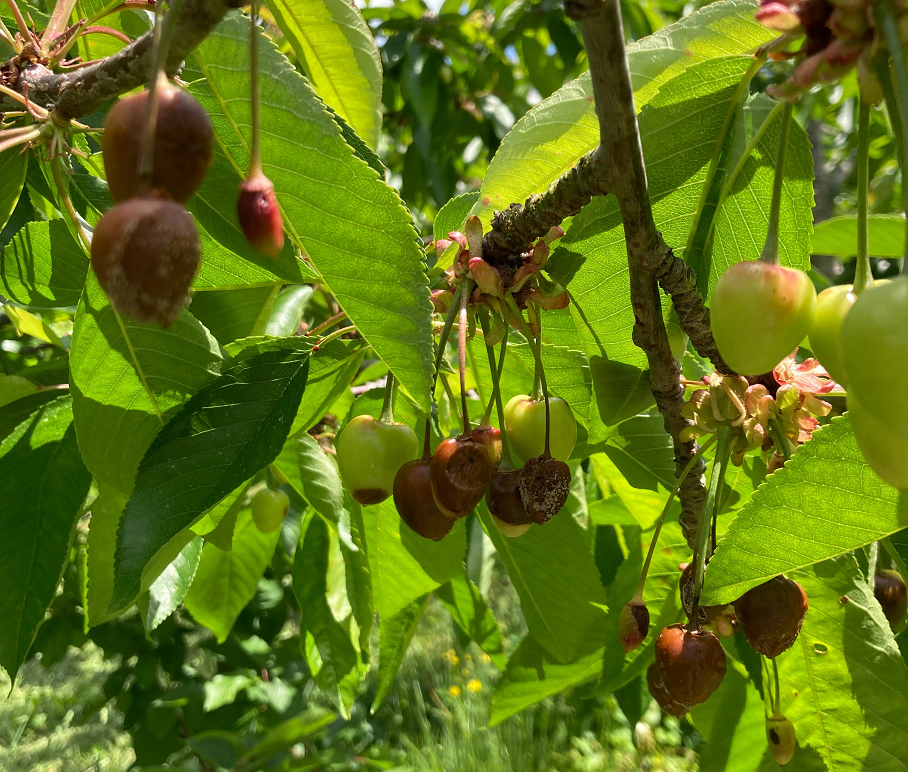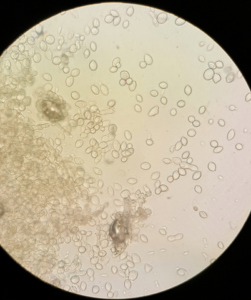Stone Fruit Disease Management Considerations in the Extremely Early Tree Growth Start of 2023

You should always protect your fruit trees no matter which year we will have and what conditions we will expect. The key point is, which fungicides and bactericides we will apply and when we decide to apply them this year will critically impact the infection pressures that will carryover to the next year (2024). Therefore, we must proceed this year with the standard protection schedules for apples and stone fruit, regardless of the concerns for the crop and frosts.
1. Peach Leaf Curl. No rest for a tree fruit grower. I have been getting a lot of questions about ziram for peach leaf curl last week and now peaches in Nelson County are in bloom raising concern for blossom blight infection of brown rot fungus Monilinia. A lot of questions about should we spray or not, of frosts will occur or not, etc. First, relying on only spring use of Ziram for leaf curl is tricky as you might not be able get into the orchard with the heavy rains we received the last two days and prior to that, making you miss to apply ziram before bud swell. Poor control of peach leaf curl is usually a result of spraying too late in the spring (after bud swell) and not applying it in fall. Missing this window and applying it after bud swell will allow infections to occur and make your ziram ineffective. Basically, bad weather will push you to apply ziram too late and make it ineffective, unless it is already on the tree applied in fall (during dormancy), or just before bud swell in spring. Ziram and copper target the spores on the twig surfaces. Once the fungus enters the new leaf tissue, the leaf curl cannot be controlled. Use of ziram in fall, just after leaf drop, has the sole purpose to protect leaf scars from leaf curl infections. Both copper and ziram are preventive contact fungicides, that must be on the bark prior to infection starts to prevent it. The reason why use of copper and Ziram in fall (dormant) is recommended is because these are most effective then. Copper will also help with Bacterial Spot of Peach. If you miss the window to apply ziram before bud break, use Bravo/Equus/Echo now as you are past bud break. Apply treatments at a minimum of 100 gals water/acre. Higher gallonage (120-150 gals/acre) generally improves coverage.
2. Brown rot blossom blight. Start brown rot blossom blight protection when flower buds start to turn pink in color. Monilinia spores (Figure 1 below) overwinter well on rotten fruit on the orchard floor, mummies on the trees, and in thin branches on the tree, especially in mild winters in Virginia. Even though we mostly worry to keep the maturing stone fruit clean from brown rot, the early spring fungicide spray applications determine the success in late season fruit protection from brown rot. The key factor to consider are the weather conditions in spring: will it be dry or a rainy spring? Dry springs are not conducive for brown rot infections on flowers. However, frequent spring showers can quickly change this, so use the most effective single-site systemic fungicides as soon as rain showers start. If you are in bloom now on peach, yes, blossom blight caused by the brown rot fungus can be a risk. However, historically, the risk in Virginia is low from blossom blight.
At pink or white bud use chlorothalonil (Bravo, Echo, Equus), in orchards where brown rot was not that big of an issue last year. If it is dry and no rains occur from white bud to shuck split, fungicide applications might not be needed at all. On the contrary, if you had high pressure brown rot last year and rain is predicted it is better to start with Indar, Elite, Tilt, Rally, Rovral, Inspire Super or Merivon (Rally, Indar and Inspire Super will also control rusty spot). The following applications should be chlorothalonil until shuck split completes (stop using this active material at schuck split). But if heavy rains continue a better option will be to use iprodione (Rovral), which is allowed for use until petal fall in apricots, cherries, peaches, nectarines, plums and prunes. You can alternate iprodione with cyprodinil (Vangard 5 oz/A) at pink and bloom on apricots, tart cherries, peaches, and plums, but do not use this AP fungicide after bloom and do not use it on sweet cherries. Scala can be used instead of Vangard on all stone fruit except cherries, and can be applied after bloom and in pre-harvest period but limit your use to 3 applications per season (Scala is labeled on apricots, peaches, and plums). You can also use Topsin M plus captan or sulfur. In some parts of Virginia, brown rot fungus was found to be resistant to the benzimidazole fungicide Topsin M. Thus use Topsin M in combination with other (non-benzimidazole) fungicides. If you experience failure in control there might be fungicide resistance issue and these events of loss in efficacy express in times of high infection pressure fueled by excessive rains and cold weather. If efficacy failures occur, change tactics to apply the highest rates on the fungicide label to achieve complete Monilinia population kill and secure good canopy coverage (spraying on days with winds 8 mph or more is not going to secure good coverage). In such orchards, do not use alternate-row spraying.

3. Black knot. If black knot has been a concern in tart cherries and plums, you have to protect the twigs from infections while they are actively growing and green. During dormant pruning, it is essential to remove the black knots on branches as they are source of infection. Cut branches 8 inches below each knot to remove them. Ascopsores are disseminated starting at bud break and lasting until the terminal shoot growth completes. The key time for infections is when young leaves are developing at the time of white bud and shuck split. In a dry spring that is less favorable, spores can have extended period of release through June. The fungus infects quickly after only a very few hours of wetting with temperatures above 55ºF, and more hours of leaf wetting are needed to infect if it is colder. Besides removing black knots by pruning you should remove any nearby host trees like wild black cherry and Japanese plum that can be source of infection. Removed black knots must be burned or buried. If black knot was a problem in your orchard, fungicide schedule of chlorothalonil (Bravo, Echo, Equus) should start at bud burst. Captan or Topsin M, which are only registered in cherries for controlling brown rot blossom blight can also be effective for black knot, and captan with Bravo is a good tank mix for both diseases. The best spray interval is 7 to 14 days, applying before rain, until terminal growth stops. In orchards with low pressure, spray schedule can be started at white bud. Stop applying chlorothalonil at shuck split.
4. Bacterial spot of peach. Infections occur at warm wet weather at shuck split in peaches, nectarines, apricots, and plums. Best defense is to use antibiotic sprays Mycoshield or FireLine. Apply these materials before rain, with peaches and nectarines requiring at least three applications: near Petal Fall and continuing at 7–10 day intervals. Keep in mind that antibiotics are not registered on apricots or plums. Low-rate copper (0.5 – 1 oz/A metallic Copper equivalent/A) may help, buy always leads to some leaf injury, so be careful. The best option is to, from week to week, alternate antibiotic with low rates of copper as per New Jersey recipe. In Pennsylvania, Kari Peter is recommending to alternate copper with Serenade ASO 4 qt/A, Serenade Opti 14 oz/A, Double Nickel 2 qt/A, and Regalia 2 qt/A. We have not tested these extensively in Virginia. I am sure you know that the best way to control this bacterial disease is to avoid planting susceptible cultivars that are released from breeding programs in California.
